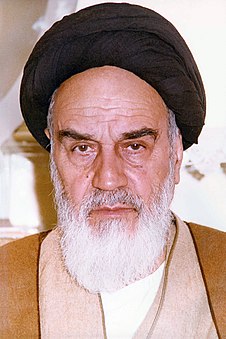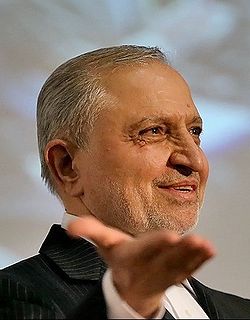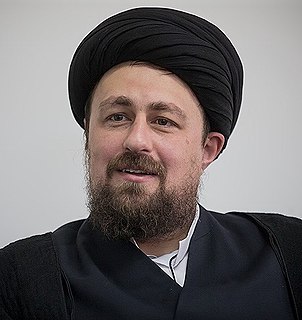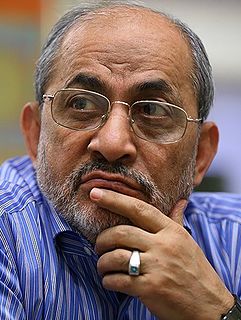| |||||
| Decades: | |||||
|---|---|---|---|---|---|
| See also: | Other events of 1989 Years in Iran | ||||
Events from the year 1989 in Iran.
| |||||
| Decades: | |||||
|---|---|---|---|---|---|
| See also: | Other events of 1989 Years in Iran | ||||
Events from the year 1989 in Iran.

The Supreme Leader of Iran, also referred to as Supreme Leader of the Islamic Revolution, but officially called the Supreme Leadership Authority, is the head of state as well as the ultimate political and religious authority of the Islamic Republic of Iran. The armed forces, judiciary, state television, and other key government organizations are subject to the Supreme Leader. The current longtime officeholder, Ali Khamenei, has been issuing decrees and making the final decisions on economy, environment, foreign policy, education, national planning, and everything else in Iran. Khamenei also makes the final decisions on the amount of transparency in elections, and has dismissed and reinstated presidential cabinet appointees. The Supreme Leader directly chooses the ministers of Defense, Intelligence and Foreign Affairs, as well as certain other ministers, such as the Science Minister. Iran's regional policy is directly controlled by the office of the Supreme Leader with the Ministry of Foreign Affairs' task limited to protocol and ceremonial occasions. All of Iran's ambassadors to Arab countries, for example, are chosen by the Quds Corps, which directly report to the Supreme Leader.

Sayyid Ruhollah Mūsavi Khomeini, known in the Western world as Ayatollah Khomeini, was an Iranian politician and marja. He was the founder of the Islamic Republic of Iran and the leader of the 1979 Iranian Revolution that saw the overthrow of the last Shah of Iran, Mohammad Reza Pahlavi, and the end of 2,500 years of Persian monarchy. Following the revolution, Khomeini became the country's Supreme Leader, a position created in the constitution of the Islamic Republic as the highest-ranking political and religious authority of the nation, which he held until his death. He was succeeded by Ali Khamenei on 4 June 1989.

Sayyid Ali Hosseini Khamenei is a marja and the second and current Supreme Leader of Iran, in office since 1989. He was previously President of Iran from 1981 to 1989. Khamenei is the second-longest serving head of state in the Middle East, as well as the second-longest serving Iranian leader of the last century, after Shah Mohammed Reza Pahlavi.

The President of Iran is the head of government of the Islamic Republic of Iran. The President is the highest ranking official of Iran. The President carries out the decrees, and answers to the Supreme Leader of Iran, who functions as the country's head of state. Unlike the executive in other countries, the President of Iran does not have full control over anything, as these are ultimately under the control of the Supreme Leader. Chapter IX of the Constitution of the Islamic Republic of Iran sets forth the qualifications for presidential candidates. The procedures for presidential election and all other elections in Iran are outlined by the Supreme Leader. The President functions as the executive of the decrees and wishes of the Supreme Leader. These include signing treaties and other agreements with foreign countries and international organizations, with Supreme Leader's approval; administering national planning, budget, and state employment affairs, as decreed by the Supreme Leader. The President also appoints the ministers, subject to the approval of Parliament, and the Supreme Leader who can dismiss or reinstate any of the ministers at any time, regardless of the president or parliament's decision. The Supreme Leader Ali Khamenei directly chooses the ministries of Defense, Intelligence and Foreign Affairs, as well as certain other ministries, such as the Science Ministry. Iran’s regional policy is directly controlled by the office of the Supreme Leader with the Ministry of Foreign Affairs’ task limited to protocol and ceremonial occasions. All of Iran’s ambassadors to Arab countries, for example, are chosen by the Quds Corps, which directly reports to the Supreme Leader.

Akbar Hashemi Rafsanjani was an influential Iranian politician, writer and one of the founding fathers of the Islamic Republic who was the fourth President of Iran from 3 August 1989 until 3 August 1997. He was the head of the Assembly of Experts from 2007 until 2011, when he decided not to nominate himself for the post. He was also the chairman of the Expediency Discernment Council.

Abdollah Noori is an Iranian cleric and reformist politician. Despite his "long history of service to the Islamic Republic," he became the most senior Islamic politician to be sentenced to prison since the Iranian Revolution when he was sentenced to five years in prison for political and religious dissent in 1999. He has been called the "bête noire" of Islamic conservatives in Iran.

The Iranian presidential election of 1989 took place on July 28, 1989, after the death of Ayatollah Ruhollah Khomeini and the selection of Ayatollah Ali Khamenei, the previous President of Iran, as the new Supreme Leader of Iran. Out of the seventy-nine candidates registered to run, only two were approved by the Council of Guardians, which resulted in a very predictable win by Akbar Hashemi Rafsanjani, the previous Speaker of Majlis.
The Guardianship of the Islamic Jurist, also called the Governance of the Jurist, is a post-Occultation theory in Shia Islam which holds that Islam gives a faqīh custodianship over people. Ulama supporting the theory disagree over how encompassing custodianship should be. One interpretation – Limited Guardianship of the Islamic Jurist – holds that guardianship should be limited to non-litigious matters including religious endowments (Waqf) judicial matters and the property for which no specific person is responsible. Another – Absolute Guardianship of the Islamic Jurist – maintains that Guardianship should include all issues for which ruler in the absence of Imams have responsibility, including governance of the country. The idea of guardianship as rule was advanced by the Ayatollah Ruhollah Khomeini in a series of lectures in 1970 and now forms the basis of the Constitution of the Islamic Republic of Iran. The constitution of Iran calls for a faqih, or Vali-ye faqih, to serve as the Supreme Leader of the government. In the context of Iran, Guardianship of the Islamic Jurist is often referred to as "rule by the jurisprudent", or "rule of the Islamic jurist".

Sayyid Ahmad Khomeini was the younger son of Ayatollah Ruhollah Khomeini and father of Hassan Khomeini. He was the "right-hand" of his father before, during and after the revolution of Iran. He was a link between Ruholah Khomeini and officials and people. He had several decision-making positions.

Abdollah Jafarali Jassbi is an Iranian academic and politician who was president of Azad University from the establishment of the university in 1982 until his resignation in 2012. He was also a presidential candidate in 1993 and 2001.

Sayyid Hassan Khomeini is an Iranian cleric. He has been called "the most prominent" grandchild of Ruhollah Khomeini, who had 15 grandchildren in total and the one "who many think could have a promising political future".

Khadijeh Saqafi was the wife of Ayatollah Khomeini, the leader of the 1979 Iranian Revolution.

Mohsen Rafighdoost is an Iranian Revolutionary Guards military officer and politician. He is a member of the Islamic Coalition Party.
Prime ministership of Mir-Hossein Mousavi were the third and fourth government of Iran after the Iranian Revolution. At that time, Ali Khamenei was the president.

In August 1981, President Mohammad-Ali Rajai and Prime Minister Mohammad-Javad Bahonar were assassinated in an explosion. Ali Khamenei was then elected as the third president of Iran in the Iranian presidential election, October 1981. He put forward Ali Akbar Velayati as his prime minister, but the Iranian parliament did not give him the vote of confidence, and he was defeated with a vote of 80 to 74. Subsequently, Ali Khamenei, though he had strong disagreements with Mousavi, as a compromise with the left-leaning parliament, agreed to offer him, Mousavi, for the post of premier. On 28 October, the parliament approved Mousavi with a vote of 115 to 39. Mousavi became the 79th Prime Minister of Iran on 31 October 1981, and remained the prime minister of Iran until 3 August 1989, for eight years.
Events in the year 2009 in the Islamic Republic of Iran.
Events from the year 1999 in Iran.
Events from the year 1988 in Iran.
Events from the year 1987 in Iran.
Events from the year 1984 in Iran.

The Supreme Leader of Iran election, 1989 was an indirect election where the Assembly of Experts members voted to choose the second Supreme Leader of Iran. The election was held on June 4, 1989, the morning after Ruhollah Khomeini's death and Ali Khamenei was elected as his successor with 60 votes out of 74.

On 8 January 2017, Akbar Hashemi Rafsanjani, the fourth President of Iran and the country's Chairman of Expediency Discernment Council, died at the age of 82 after suffering a heart attack. He was transferred to a hospital in Tajrish, north Tehran without consciousness. Attempts at cardiopulmonary resuscitation for more than an hour trying to revive him were unsuccessful and he died at 19:30 local time (UTC+3:30).
| This year in Iran article is a stub. You can help Wikipedia by expanding it. |